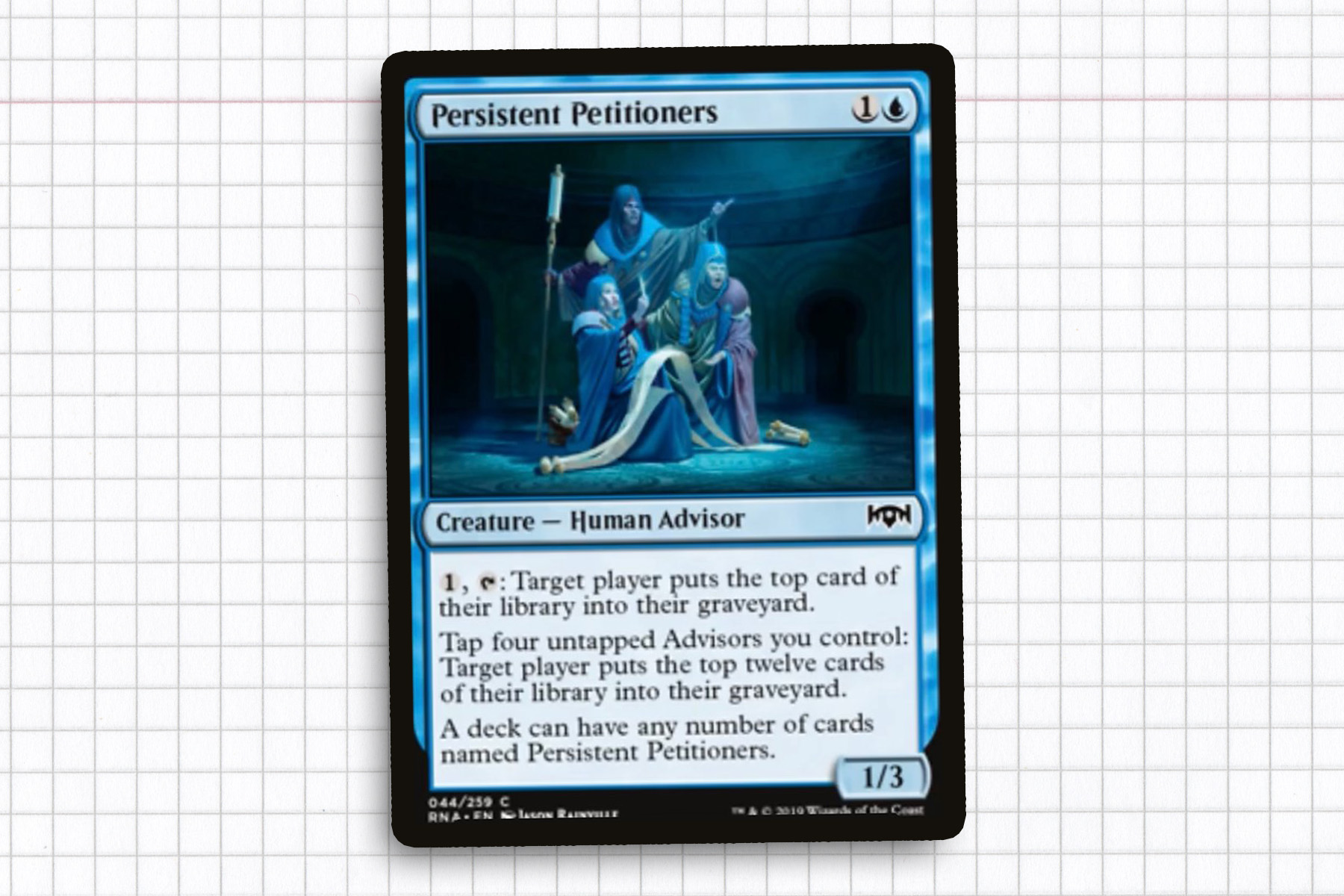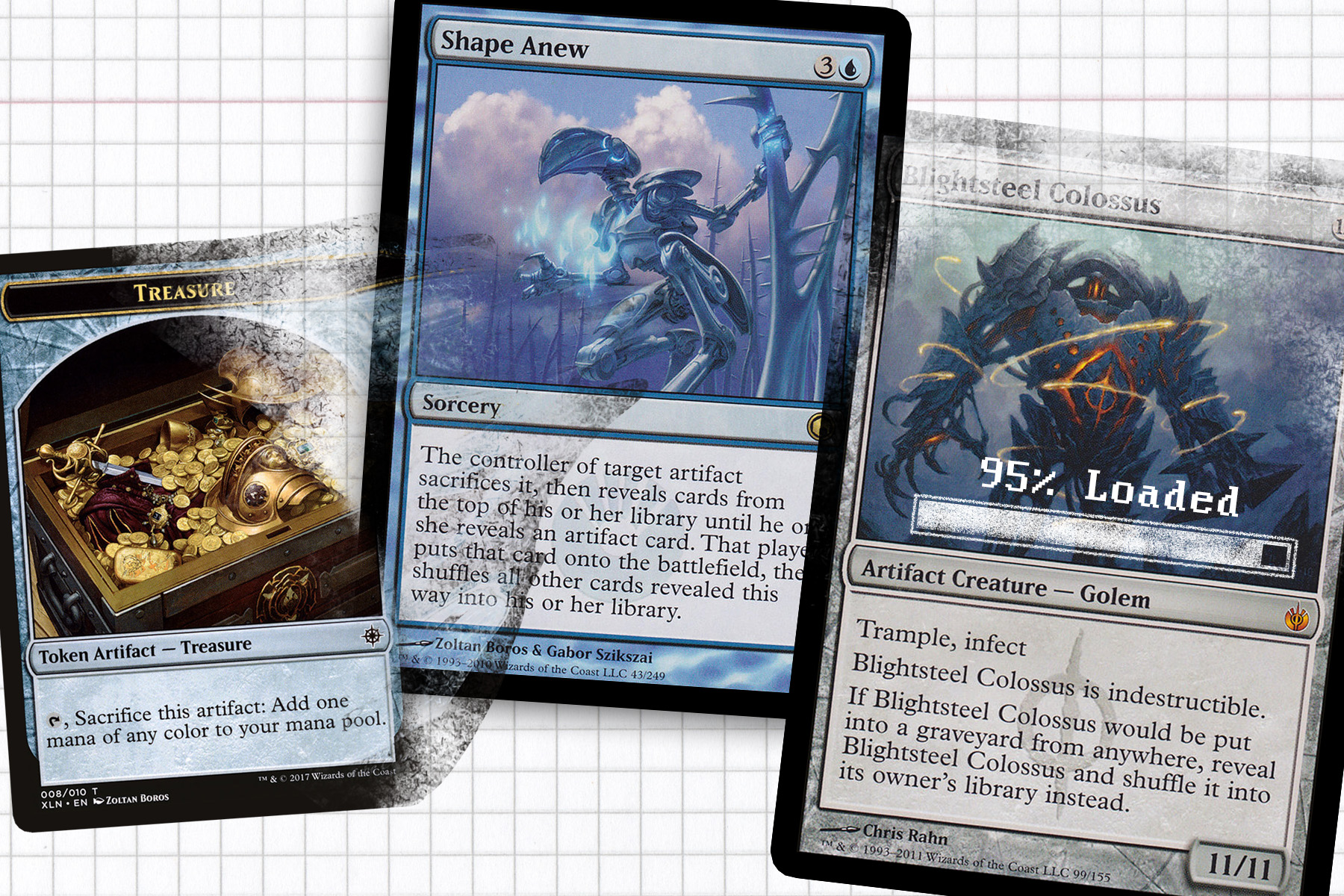It saddens me to say that my love affair with the mill deck was not something that I immediately found when I started playing Magic. For all the bad decks I built between Onslaught and Future Sight, mill was never even on my radar. When I returned to the game in 2009 to draft Magic 2010, I found Tome Scour, and instantly the idea of winning through mill in Limited intrigued me so much that it sparked the flame that would slowly build until an amazing 3-1 showing at a Friday Night Magic Modern event in 2014. And then the trail went cold—I moved on to Commander as my main form of Magic, and some occasional Modern Eldrazi Tron for team events.
But wouldn’t you know it on the morning of January 10th, 2019, we were delivered a preview from Strictly Better MTG and my entire Magic career suddenly felt like it had a new purpose.

When I saw this card I reacted like Randy Buehler looking at a top-decked Lightning Helix. As a Commander player I would be lying if I didn’t say that I was a little over the moon about this card. The ability to make a entirely viable Mill strategy work in a 100-card format is actually a very intriguing, especially with how loose that format is. But today I wanted to look at Persistent Petitioners not as a Commander card but in a Modern context.
This is obviously the time for the obligatory I am not a Modern player disclaimer and thus a serious tournament grinder probably won’t sleeve this decklist to try to win the next Magic Fest. But I will say that I am completely serious that I would sleeve up something like this to go play in a Modern event in a card shop. I present my next Modern decklist:
Modern Persistent Mill
| Creatures (25) 4 Mothdust Changeling 4 Minister of Inquiries 17 Persistent Petitioners Spells (13) 4 Dispel 3 Negate 4 Archive Trap 2 Fraying Sanity | Lands (22) 4 Ghost Quarter 18 Island Sideboard (15) 4 Sailor of Means 4 Shape Anew 2 Blightsteel Colossus 4 Aether Swooper 1 Island |
Persistent Mill
But let’s talk about what I’m looking to do with this deck, because it’s probably a jarring mess for anyone who knows that format and sees how quickly it will lose to Humans, Death’s Shadow, and KCI. Up front, I was tempted to be greedy and include White for spells like Path to Exile, Holy Day, and Etheral Haze or maybe even push my luck with copies of Dramatic Reversal and Paradox Engine. But pretending to be the composed deckbuilder I thrive to be, the maindeck was constructed under the premise that we want to be low to the ground to keep our mana open for counter spells, dropping Persistent Petitioners on turn three, with three one-mana advisors already in play. Commence milling.
This plan will result in an opponent with zero cards in their deck in four turns, which admittedly is too slow to be our only route to victory. This is where Archive Trap becomes an important piece of our deck, both as a rattlesnake effect for anyone who identifies our deck as a mill deck and an extra Petitioners activation, cutting our win condition down by one more turn. Archive Trap is a card that, once played, becomes something that players have to actively play around. It can turn Ghost Quarter into Strip Mine and Path to Exile into Swords to Plowshares with no downside. Against an unprepared opponent, I expect to take a lot of game ones.

The Blightsteel in the Room
Then we have my proposed sideboard. I have to be entirely honest, I love the idea of transformative sideboards, but they come along very rarely due to the sheer fact of how difficult they can be to pull off. But here, I see the perfect chance to subvert expectations in the event of a horrible matchup by transitioning into a Shape Anew for Blightsteel Colossus deck. The plan is relatively simple: over the course of the first three turns of the game, we want to get an artifact token into play either through Aether Swooper or Sailor of Means. From there we cast Shape Anew, with Blightsteel Colossus being the only possible target in the deck to hit. This works because the maindeck already doesn’t have any artifacts—though I momentarily considered a Thrumming Stone—meaning that we don’t have to remove anything specific to make this deck work. From there we have an indestructible one-turn clock.
What we’re fighting is the assumption that after the first game, a savvy opponent is likely to sideboard in an Ulamog, the Infinite Gyre or Surgical Extraction to circumvent our plan. By transitioning to a Shape Anew deck, our opponent will misfire when they move from Rock to Scissors and we’ve moved away from Paper to become Rock. It’s a lot easier to have an unprepared opponent if you play with cards they’ll never prepare against.
Going Rogue
While a seasoned Magic player should be able to tell exactly what this deck is going to do on turn one or two—especially if I cast Minister of Inquiries on turn one—the ability to be a rogue deck that people can’t prepare for with their maindeck or sideboard can be very valuable.
From my experience playing in local Magic events where I tried to pilot the best deck, I was beaten by other people who had mastered their archetype. I went 2-2 and went home feeling like my investment of time was wasted. Playing a rogue deck that I crafted myself has the advantage of making that 2-2 night the drive I need to return next week to seek a 3-1 night. It’s all about perspective.
Mill decks have been the butt of jokes in terms of viability for much of my Magic career, and I would be arrogant to not understand why. While mill decks have seen success in smaller tournaments against less serious players, there has not been a deck that has caught my attention that wins by milling that isn’t a chore to pilot. The decks normally have to win on the back of Time Warp variants and heavy counter magic, or whatever Lantern Control does, whereas Snapcaster Mage and Lightning Bolt look a lot safer.
But I think with uniqueness of Persistent Petitioners, there might be something viable waiting to be the perfect metagame call for a tournament. All that is left for me is waiting patiently for Persistent Petitioners to be released at the end of the month and then find a real life or MTGO tournament to crush. Until then, thanks for reading.
Ryan Sainio is a Graphic Designer who writes about EDH, the EDH community, and streams on Twitch in his down time. He has been playing Magic: The Gathering since 7th Edition in 2002 and values flavorful and fun gameplay over competitively optimized decks. Join him for a stream at twitch.tv/hipstersainio on Tuesday nights.

